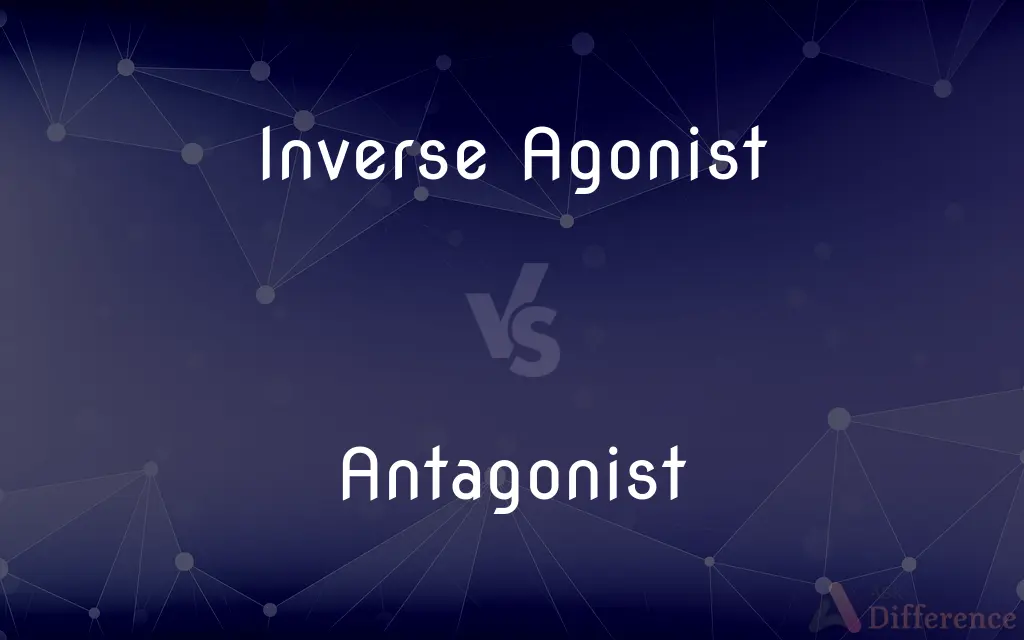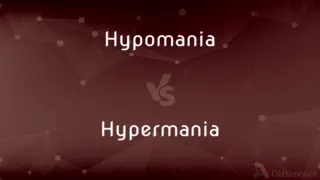Inverse Agonist vs. Antagonist — What's the Difference?
By Urooj Arif & Maham Liaqat — Published on August 18, 2024
An inverse agonist reduces the activity of a receptor below its basal level, while an antagonist merely blocks or dampens the receptor's response to agonists without altering its basal activity.

Difference Between Inverse Agonist and Antagonist
Table of Contents
ADVERTISEMENT
Key Differences
An inverse agonist binds to the same receptor as an agonist but induces a pharmacological response opposite to that of the agonist. It decreases the receptor's activity below its basal, or normal, level of activity, effectively producing effects that are the inverse of the agonist's action. On the other hand, an antagonist binds to a receptor but does not activate it, nor does it reduce the receptor's activity below its basal level. Instead, it prevents agonists from binding to the receptor and activating it, thus blocking or dampening the receptor's response to agonists.
The distinction between the two lies in their effect on the receptor's basal activity. While an inverse agonist actively decreases the receptor's activity below its normal operation, leading to an effect that is opposite to that of an agonist, an antagonist simply stops the receptor from being activated further by agonists, maintaining the receptor's activity at its basal level.
In therapeutic applications, inverse agonists are used to decrease the constitutive activity of receptors that might be contributing to a disease state or condition, offering a unique approach to modulation of receptor function. Antagonists, by preventing the binding of endogenous or exogenous agonists, are used in situations where blocking the action of agonists is desired, such as in the case of blocking the effects of excess neurotransmitters or hormones.
Understanding the difference between inverse agonists and antagonists is crucial in pharmacology and medicine, as it informs the choice of treatment strategies and the development of drugs targeting specific receptors to achieve desired therapeutic outcomes.
Comparison Chart
Receptor Activity
Decreases below basal level
Maintains basal level
ADVERTISEMENT
Effect on Agonist Action
Produces opposite effect
Blocks or dampens effect
Binding Site
Same as agonist
Same as agonist
Therapeutic Use
Reduces constitutive receptor activity
Blocks agonist-induced receptor activity
Example
Inverse benzodiazepine agonists reducing anxiety by decreasing GABA receptor activity
Beta-blockers blocking adrenaline receptors to manage hypertension
Compare with Definitions
Inverse Agonist
Distinct from antagonists by reducing basal activity.
Unlike antagonists, inverse agonists can diminish the baseline function of receptors, offering unique therapeutic benefits.
Antagonist
Maintains receptor's basal activity level.
Beta-blockers, as antagonists, maintain the basal activity of adrenergic receptors while blocking excessive stimulation by adrenaline.
Inverse Agonist
A compound that reduces receptor activity below its basal level.
Certain drugs acting on GABA receptors serve as inverse agonists to reduce anxiety by lowering the receptor's inherent activity.
Antagonist
A substance that blocks or inhibits receptor activation.
Naloxone is an opioid antagonist used to reverse opioid overdose by blocking opioid receptors.
Inverse Agonist
Used to decrease unwanted constitutive activity.
Inverse agonists are researched for their potential to treat diseases related to overactive receptors, like certain neurological disorders.
Antagonist
Prevents agonists from binding to receptors.
Antihistamines work as antagonists by preventing histamine from binding to its receptors, alleviating allergy symptoms.
Inverse Agonist
Opposes constitutive activity of receptors.
Inverse agonists targeting the histamine H3 receptor can modulate brain activity by decreasing its constitutive action.
Antagonist
Widely used in therapeutic settings.
Antagonists are commonly prescribed to counteract excessive or undesirable effects of endogenous compounds or drugs.
Inverse Agonist
Can have therapeutic implications in various diseases.
Investigating inverse agonists for their role in managing conditions where downregulation of receptor activity is beneficial.
Antagonist
Does not induce an inverse response.
Unlike inverse agonists, antagonists do not decrease receptor activity below its basal state, merely blocking further activation.
Antagonist
One who opposes and contends against another; an adversary.
Antagonist
The principal character in opposition to the protagonist or hero of a narrative or drama.
Antagonist
One who antagonizes or stirs.
Antagonist
(biochemistry) A chemical that binds to a receptor but does not produce a physiological response, blocking the action of agonist chemicals.
Antagonist
One who contends with another, especially in combat; an adversary; an opponent.
Antagonist of Heaven's Almigthy King.
Our antagonists in these controversies.
Antagonist
Antagonistic; opposing; counteracting; as, antagonist schools of philosophy.
Common Curiosities
In what situations might an inverse agonist be preferred over an antagonist?
Inverse agonists are preferred when it's necessary to reduce the constitutive activity of a receptor that is contributing to a disease or disorder, offering a therapeutic advantage in such conditions.
What role do antagonists play in drug therapy?
Antagonists are commonly used in drug therapy to block the effects of excessive or harmful endogenous substances or exogenous agonists, without altering the receptor's normal activity level.
Can an antagonist reduce the basal activity of a receptor?
No, antagonists maintain the basal activity of a receptor by preventing agonists from binding and activating the receptor, but do not reduce the activity below the basal level.
What is an inverse agonist?
An inverse agonist is a compound that binds to the same receptor as an agonist but induces an opposite response, lowering the receptor's activity below its basal level.
How do inverse agonists affect receptors with constitutive activity?
Inverse agonists decrease the activity of receptors with constitutive activity, meaning they can lower the activity of receptors that are active even in the absence of an agonist.
Can the same compound act as both an antagonist and an inverse agonist?
The action of a compound, whether as an antagonist or an inverse agonist, depends on the specific receptor and its state (e.g., presence of constitutive activity), so it's theoretically possible for a compound to have both actions under different circumstances.
Are inverse agonists and antagonists used for the same types of conditions?
While both can be used in therapeutic settings, their applications differ based on whether reducing below-basal receptor activity (inverse agonists) or blocking agonist-induced activity (antagonists) is desired.
How does an antagonist differ from an inverse agonist?
An antagonist blocks or dampens the receptor's response to agonists without altering its basal activity, whereas an inverse agonist decreases the receptor's activity below its basal level.
How do inverse agonists contribute to drug development?
Inverse agonists contribute to drug development by offering a novel approach to modulating receptor activity, especially for conditions associated with overactive receptors, providing new therapeutic avenues.
What is basal activity in the context of receptor pharmacology?
Basal activity refers to the intrinsic activity level of a receptor in the absence of any bound agonist, representing the receptor's default or background level of activity.
Share Your Discovery

Previous Comparison
Classic Fit vs. Modern Fit
Next Comparison
Natural Gas vs. LPGAuthor Spotlight
Written by
Urooj ArifUrooj is a skilled content writer at Ask Difference, known for her exceptional ability to simplify complex topics into engaging and informative content. With a passion for research and a flair for clear, concise writing, she consistently delivers articles that resonate with our diverse audience.
Co-written by
Maham Liaqat













































